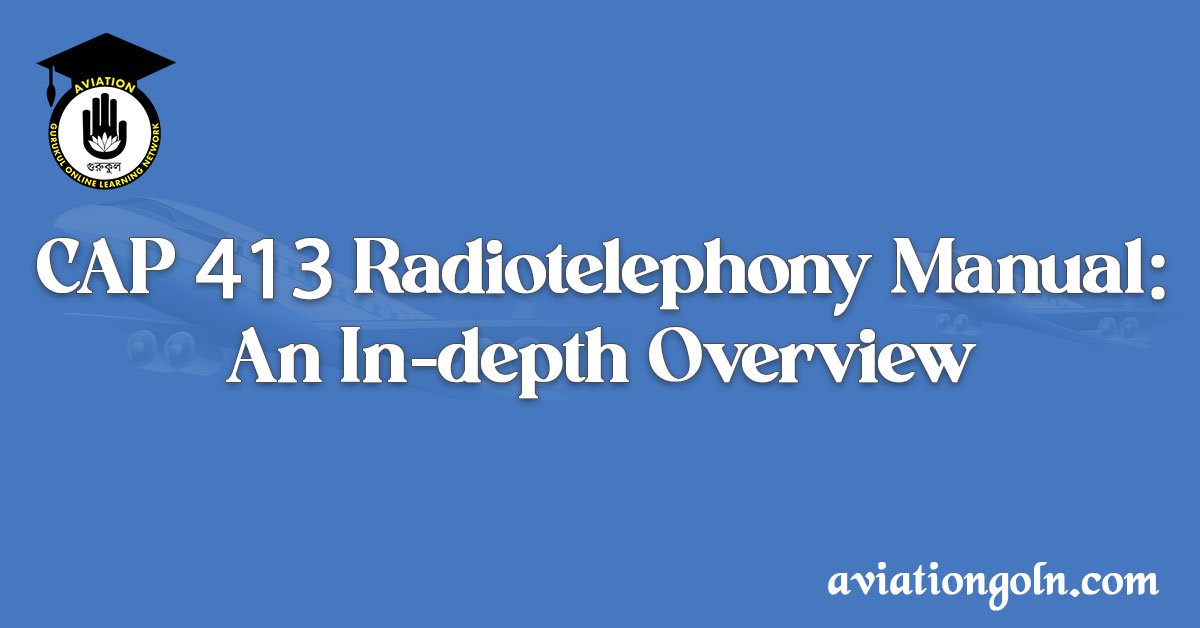CAP 413 Radiotelephony Manual: The UK Civil Aviation Authority (CAA) has consistently endeavored to provide accurate guidelines and protocols for ensuring the safety and efficiency of the UK’s aviation sector. One of their pivotal publications in this regard is the CAP 413 Radiotelephony Manual. As of the 23rd edition, effective from 17 August 2020, this manual stands as the cornerstone for radiotelephony communications within the UK’s airspace. Let’s delve into its importance, main features, and updates.
Download CAP 413 Radiotelephony Manual – CAP413 E23 A1 26Nov2020

What is Radiotelephony?
Radiotelephony, commonly abbreviated as R/T, is a means of communication in which a voice message is transmitted via radio waves. In aviation, it’s a critical means for pilots to communicate with air traffic control (ATC) and other aircraft. Its primary purpose is to ensure aircraft operate safely, avoid collisions, and follow proper flight procedures.

Significance of CAP 413 Radiotelephony Manual
In the vast world of aviation, clear and concise communication is crucial. Miscommunications or misunderstandings can have severe consequences, including air incidents or accidents. CAP 413 serves as the standard reference for both pilots and ATC personnel, ensuring everyone uses a consistent and clear language while communicating.
Key reasons for the importance of CAP 413:
- Safety: The manual establishes procedures and phraseology to minimize ambiguity and potential misunderstandings.
- Efficiency: By standardizing radiotelephony communications, air traffic is managed more efficiently, reducing delays and fuel consumption.
- Clarity: With a set format and vocabulary, CAP 413 ensures all parties involved in an aviation communication understand each other, despite potential language barriers.

Key Features of the 23rd Edition
The CAP 413 Radiotelephony Manual, in its 23rd edition, encompasses various aspects of radiotelephony communication. Some of the significant sections include:
- General Operating Procedures: This section outlines the basic rules and standards for radiotelephony communications, ensuring pilots and ATC officers know the proper etiquette and protocols.
- Phraseology: It offers standardized wordings and terminologies that should be employed during communications. This minimizes the risk of misunderstandings.
- Emergency Communications: In the unfortunate event of an emergency, CAP 413 provides a structured set of procedures and phrases to be used. This ensures that urgent situations are dealt with promptly and accurately.
- Use of English in Aviation: English is the international language of aviation. This section details the correct usage of the language, emphasizing clarity and precision.
- Special Procedures: It details procedures for various specific scenarios, such as military interactions or when flying in certain types of airspace.
- ATIS (Automatic Terminal Information Service) and VOLMET Broadcasts: This section offers guidelines on how these essential services should be utilized and communicated.
- Examples of Radiotelephony Communications: To provide practical insights, the manual includes examples of common communications between pilots and ATC.

Updates in the 23rd Edition
Every new edition of CAP 413 is an evolution based on lessons learned, technological advancements, and changes in aviation protocols. Here are some notable updates in the 23rd edition:
- Enhanced Clarity: The 23rd edition provides more explicit guidance in certain areas to ensure better understanding and application of the procedures.
- Additional Scenarios: As the world of aviation evolves, new situations arise. The latest edition includes procedures and phraseologies for emerging scenarios or those that needed more detailed attention based on feedback and incidents.
- Technological Updates: With advancements in communication technologies and tools, the manual has been updated to incorporate these changes, ensuring it remains relevant.
- Feedback Integration: The CAA continually gathers feedback from professionals in the field. The 23rd edition integrates this feedback to address real-world challenges faced by pilots and ATC officers.

Challenges and the Future
As aviation continues to grow and evolve, so does the complexity of managing air traffic. CAP 413 is a living document, adapting to the times and challenges of the industry.
Future editions might need to address:
- Increased Air Traffic: As air traffic grows, the potential for communication errors or misunderstandings increases. Future editions will need to ensure even greater clarity and precision.
- Drones and Unmanned Aircraft: The increasing prevalence of drones and other unmanned aircraft in airspace presents new communication challenges.
- Digital Communication: As technology evolves, there might be a shift towards more digital or automated communication systems. How these integrate with traditional radiotelephony will be a challenge for future editions.

The CAP 413 Radiotelephony Manual by the UK CAA remains a fundamental reference for aviation professionals. By standardizing communication procedures and ensuring clarity in interactions, it plays a pivotal role in maintaining the safety and efficiency of the UK’s airspace. As the aviation landscape continues to change, the manual will evolve, reflecting the industry’s needs and challenges. For pilots, ATC officers, and anyone involved in aviation communications, staying updated with the latest edition of CAP 413 is not just recommended—it’s essential.
